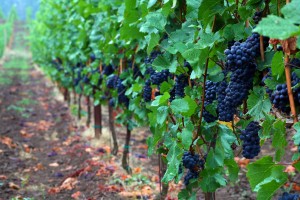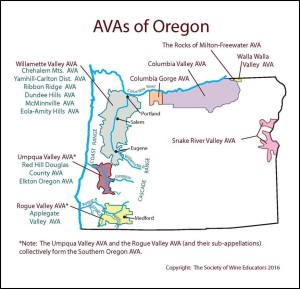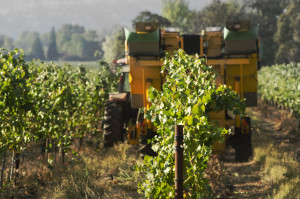Oregon’s Willamette Valley AVA, first established in 1983, just got a little bit bigger. Actually, it just got a teeny-tiny bit bigger, having been expanded by 29 square miles—from approximately 5,360 square miles to approximately 5,389 square miles (even the TTB calls this an approximation). This represents an increase of 0.5%. The TTB approved the rule expanding the AVA on March 3, 2016, and it will become official on April 4th.
The expansion area is located at is southern end of the established AVA. The newly designated areas fill in some of the viticultural “no-man’s-land” located between the southern end of the Willamette Valley AVA and the north/northeast boundary of the Umpqua Valley AVA.
While 29 square miles out of a total 5,389 might not sound very significant, it is highly significant to two wineries that own vineyards in newest section of the AVA. These two wineries, King Estate and Iris Vineyards, can now bottle a good deal of their wine under the Willamette Valley AVA—an obvious benefit to the reputation (and likely price point) of the wine.
Interestingly enough, the application for the expansion of the AVA detailed the features of the expansion zone that are similar to the original AVA (whereas most AVA applications only try to differentiate themselves from the surrounding areas). Here is what the author of the petition, Steve Thomson (Executive Vice President of King Estate Winery) had to say about the area:
Topography: The expansion area is, like the established AVA, composed of rolling hills between the Coast Range Mountains (to the west) and the Cascade Mountains (to the east) at elevations ranging from 500 feet to 1,200 feet. By contrast, the region outside the expanded AVA is much more rugged, mountainous, and at higher elevations.
Watershed: The expansion area is located within the watershed of the Willamette and Siuslaw Rivers, as is the established AVA. The region to the south of the expansion area is located in the watershed of the Umpqua River (as is the Umpqua Valley AVA).
Soils: The soils in the expansion area are mainly comprised of the same types of soils found in the established Willamette Valley AVA, including Willakenzie, Dupee, Jory, Bellpine, and Peavine. The area outside of the new boundaries of the AVA is mainly comprised of different soil types (although it does contain some Peavine soils).
Climate: The climate of the expansion area in terms of annual mean temperature, precipitation, and degree days—while slightly cooler than the average of the established Willamette Valley AVA—is much closer to the overall climate of the Willamette Valley AVA than it is to the climate data of the Umpqua Valley AVA or its surrounding areas.
This is a minor adjustment to the boundaries of an existing AVA—even the TTB, in its calculated legalese admits that it is “not a significant regulatory action” and “will not have a significant economic impact on a substantial number of small entities.” However, we are guessing that Iris Vineyards and King Estate will be doing some serious celebrating, and it is always good to have a reason for cheer.
So…we’d like to say “Welcome to the brotherhood of AVAs” to the new 29 square-mile region of the Willamette Valley AVA!
Click here to access the original documents concerning the Expansion of the Willamette Valley AVA Ruling via the Federal Register of March 3, 2016
post authored by Jane A. Nickles…your blog administrator
Are you interested in being a guest blogger or a guest SWEbinar presenter for SWE? Click here for more information!


